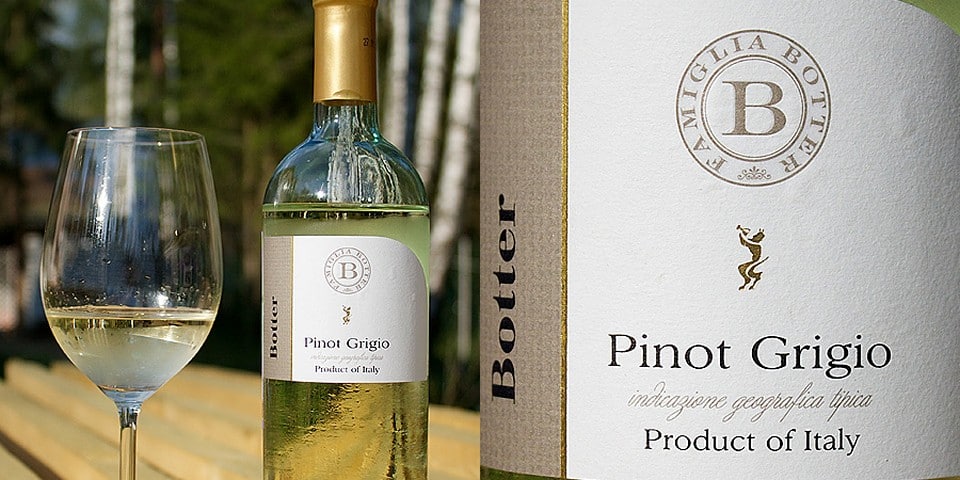An astonishing fact about the emergence of Pinot Grigio, a dry white wine, is its origin. The grape variety used to produce Pinot Grigio is not a wild plant tamed by human hands or a result of selective breeding; it is actually a genuine mutation of Pinot Noir berries.
This peculiar variety did not have the green skin typical of other white grape varieties. Its grayish-blue surface inspired its name, which translates from French as “gray cone.” Thus, this unusual raw material became the mother of the now famous beverage. Pinot Grigio is a treasure trove of interesting information, which we will share with you in our article.
Page Contents
Origin
While most people believe that Pinot Grigio grapes were born in Italy, they were actually first discovered in France, where they are called Pinot Gris. The wine itself was made in Burgundy and immigrated to other countries in the 14th century.
Pinot Gris berries found a home in northern Italy, acquiring an Italian sound and the name Grigio. The new beverage had the most success in regions such as Lombardy, Veneto, Friuli-Venezia Giulia, and Trentino-Alto Adige.
Vineyards firmly established themselves in the suitable climate of the northern part of the country, while the new drink won the hearts of people throughout the republic. However, the Italian market today doesn’t have a strong demand for Pinot Grigio.
Therefore, 80% of the produced bottles are exported to the United States, the United Kingdom, China, and Japan, where the demand is constantly growing.
Description
Pinot Grigio is a dry white wine, with an average alcohol content of around 11%. The color of this beverage varies depending on the winemaking methods used. For instance, if the final fermentation process occurred without contact with the skin, the wine turns out to be light and clear. However, if the producers utilized a fermentation method that combines the must with grape berries, the result will be a beverage of an almost copper color.
The majority of vineyards are located in just three regions of the country: Veneto, Friuli, and Trentino. Their combined area is approximately 53,819 acres (around 21,800 hectares).
Taste Characteristics Varieties
Unlike other wine types, different Pinot Grigios don’t have roughly the same taste characteristics. Three styles of wine from the ‘gray’ grape are distinguished:
- Mineral and dry;
- Fruity and dry;
- Fruity and sweet.
The mineral and dry style is the most common in northern Italy. Stainless steel tanks are used for its maturation. Oak barrels are never employed, and malolactic fermentation is not carried out. The aroma comes with hints of lemon, lime, and apple. The alcohol content is between 10 and 12.5%.
The fruity and dry style is typical for regions like Friuli Venezia Giulia, Abruzzo, Sicily, and Lazio. It’s known for aromatic notes of lemon, yellow apple, and white peach. Wines of this type exhibit less intense acidity and a more ‘fat’, textured taste. Some producers introduce microorganisms into the wine after primary fermentation, which process the acid, making the Pinot softer. This process is called malolactic fermentation. Fruity-dry wines are matured both in stainless tanks and oak barrels (but not new ones).
Fruity-sweet variants of Pinot Grigio are only produced in the French Alsace. These beverages typically have a taste of lemon candies with honey apples.
Surprisingly, there’s also a rose variant of the ‘gray’ wine. It is obtained by macerating grape juice with skins for 24-36 hours. Such a version can be found in Friuli Venezia Giulia. It’s called Ramato. Depending on the producer, the taste of pink Pinot has notes of white raspberry, sour cherry, and dried cranberry in the aftertaste.
In addition, there are wineries experimenting with the beverage’s flavor by maturing it for a long time in wooden barrels.
Varieties by Production Territory
Different regions of Italy differ from each other not only in climatic conditions but also in soil composition. This significantly influences the taste and aroma of the grapes. On Pinot Grigio bottles, words in the name indicate the production area.
The following list of the most demanded varieties will help you choose the best beverage for yourself:
- COLLIO – a hilly territory in the province of Gorizia. The soil consists of clayey marl, alternating with sandy layers. The wine turns out to be full-bodied, with high alcohol content, aromatically complex. Such drinks are assigned the DOC category.
- ISONZO – a flat territory of Gorizia, which runs in the Isonzo river valley. The soils are rocky, more or less limestone. From here comes a mineral and very juicy Pinot. Isonzo wines are also classified as DOC.
- FRIULI GRAVE – a broad area stretching from the foothills of the Alps to the sea. The soils are rich in minerals, the climate is cool with a large difference in day and night temperatures. Local Pinot Grigio is endowed with excellent minerality and high aroma. The drinks are awarded the DOC quality mark.
- VENETO ORIENTALE – territory of Eastern Veneto. Here the soils are clayey, saturated with salts, and very fertile. The wines turn out to be powerful with a simple aroma but pleasant to consume. Such Pinot Grigio variants are classified as IGT.
- VERONESE – the area of the municipality of Soave, where the land is of volcanic origin and rich in inorganic substances. This gives us aromatic, complex, elegant wines. Like the previous type, such drinks have the IGT quality mark.
- TRENTINO – the area of the Bolzano province. The climate here is characterized by a large temperature fluctuation in day and night time. From this area come fresh drinks with a rich bouquet of aromas. For high-quality Pinot Grigio Trentino are marked with the DOC category.
In reality, there are many more Pinot subtypes, endowed with quality marks. For example, pay attention to Pinot Grigio delle Venezie (Pinot Grigio delle Venezie IGT). This is an aromatic yellow drink with a greenish hue. It has a scent with notes of acacia flowers and shades of pear. It is harmonious, fresh, quite intense, and easy to drink.
There is an opinion that Pinot Grigio is of questionable quality. This is not true at all, although such thoughts can be justified. Today, there are a huge number of producers of the “gray” drink. Not all of them strive to keep the quality of the wine at the proper level.
Therefore, when choosing your Grigio in the store, prefer bottles marked with the DOC or IGT category.
How and What to Drink Pinot Grigio With
The high level of acidity in Pinot Grigio creates a limitation on the terms of its consumption. Experts recommend drinking it young, within no more than a year from the date of sale.
The wine is served chilled to 46-50°F (8-10°C), poured into an almost icy glass. An open bottle is stored in a dry, cool place, protected from light.
“Grey” wine is consumed as an aperitif. It goes well with fish snacks, seafood salads, seafood risotto. The drink also wonderfully accompanies pasta dressed with fried tomatoes, pasta with cheese sauce, mushroom dishes, white meat, cheeses, and omelettes.
Pinot Grigio is a versatile wine that pairs well with a variety of dishes, making it a great choice for dinners and parties. Remember to enjoy it responsibly, and if you have any more questions about wine or food pairing, feel free to ask.
Seven Interesting Facts about Pinot Grigio
Here are 7 interesting facts about Pinot Grigio, memorize a few and surprise your friends during the tasting:
- Pinot Grigio’s roots in Italy go as far back as the Middle Ages. But it wasn’t until the 1960s that the grape really gained recognition. The Santa Margherita Winery in the northeastern region of Veneto started to produce a dry, fresh, and light white wine from Pinot Grigio grapes. This style, different from the more common sweet wines of the time, revolutionized the perception of Italian white wines globally.
- The Pinot Grigio grape, a natural mutation of the Pinot Noir, is characterized by a greyish-blue color, thus the name “Grigio”, which means “gray” in Italian. Interestingly, due to its mutation, the wine produced can vary significantly in color, ranging from deep golden yellow to copper, and even light pink, providing a unique palette of flavors and aromas in each bottle.
- Italy is the world’s top producer of this wine, producing nearly two-thirds of all Pinot Grigio worldwide as of 2020. The majority is grown in the northern regions of Veneto, Friuli-Venezia Giulia, and Alto Adige. These regions have the ideal terroir with cool climates and hilly areas, making them perfect for growing this grape variety.
- Pinot Grigio wines are known for their light, zesty, and crisp flavor profile. A bottle typically has an alcohol content of around 12.5% to 13.5%. The wine is best enjoyed young, as its freshness and vibrancy begin to fade after a couple of years, unlike other white wines that can be cellared for longer.
- The versatility of Pinot Grigio is unparalleled. Due to its light body and high acidity, it pairs exceptionally well with a variety of food. This delightful wine commonly accompanies traditional Italian dishes such as seafood pasta, prosciutto, and mozzarella, proving its significant role in Italian cuisine.
- While Italy remains the principal producer, the global popularity of Pinot Grigio has led to its cultivation in other parts of the world. As of 2023, the United States, Australia, and Romania are among the top producers outside Italy, each adding their unique terroir characteristics to this versatile grape.
- In the 1970s and 80s, Pinot Grigio gained immense popularity in the United States, specifically as an alternative to the oaky, full-bodied Chardonnays that dominated the market. Its crisp, light, and dry qualities struck a chord with wine lovers who were seeking something different, solidifying its place in the global wine market.
FAQ about Pinot Grigio
How many calories are in a Pinot Grigio bottle?
Is Pinot Grigio white or red?
What does Pinot Grigio taste like?
What does Pinot Grigio mean?
What does Pinot Grigio pair with?
How long is Pinot Grigio good for after opening?
How long does Pinot Grigio last unopened?
Where is the best Pinot Grigio from?
What type of wine is a Pinot Grigio?
Price in Italy
Buying quality wine doesn’t mean you’ll have to break the bank. In Italy, the price for a bottle with an IGT or DOC category ranges from 5 to 15 Euros. At the same time, the most expensive options are sold with about 2 years of aging.
The article has come to an end, and now for you a chest of facts about Pinot Grigio has been opened a crack. Live wisely, hurry to love, travel, dream, and remember that in the riddle “Say grey, imply white?” there is only one answer. Have you guessed what it is? It’s the Pinot Grigio, the grey-skinned grape that produces white wine!
 Italy for me From Italy with love
Italy for me From Italy with love





